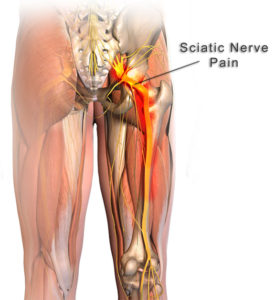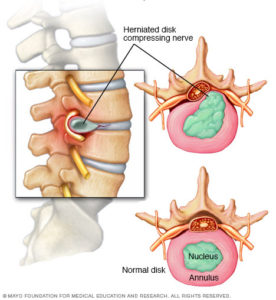We hear it often: “I have sciatica.” But what we rarely hear when people come into our office is why. That’s because “sciatica” is not a diagnosis; it’s not the actual issue. It is a description of symptoms.
Simply put, sciatica describes the irritation or compression of the sciatic nerve. So, it’s a type of nerve pain.
This pain typically starts on the spine and radiates down the back of one leg. You may feel sharp pain in the back, glutes, leg, or hip. Pain can also be mild, feel like pins and needles, or cause numbness or burning in the leg or foot. But other issues can cause similar symptoms, which is why sciatica is frequently misdiagnosed – especially if you’re self-diagnosing using Dr. Google.
A comprehensive exam by our experts is a more accurate way to know for certain if your sciatic nerve is angry – and why. The latter, the source of the issue, helps determine the proper treatment to relieve the pain. Without understanding the cause, you cannot get the appropriate treatment.
What is the Sciatic Nerve?

The sciatic nerve is a thick nerve (about the width of your thumb) that runs through the glutes and down the back of the leg, into the foot. It’s a significant size – the largest nerve in the body – so when it’s irritated, it can be a pretty big pain in the butt (literally).
It’s not actually one single nerve, but rather a collection of nerves that exit the lower lumbar spine and the sacrum and then come together.
Sciatic pain is common. It can be caused by trauma or degeneration. Genes and body structure can play a role, too.
The good news is most causes can be treated in our office without invasive techniques.
6 Common Causes Of Sciatica
Sciatica has many different causes, and some of them can be more serious than others. Here’s a look at the six most common causes of sciatica.
1. Lumbar Disc Herniation 
One symptom of disc herniation can be pain shooting down the leg. This is caused by pressure on the sciatic nerve. That can be either direct pressure on the nerve root by the disc itself, or indirect pressure on the nerve root due to chemical irritants that are released, triggering pain and inflammation. Essentially, there can be little cuts (from wear and tear) on the disc, and the body creates so much inflammation in response that it irritates the nerves in the area.
Whether the pressure is direct or indirect, it can cause low back pain, muscle spasticity, limb pain, numbness, and the loss of motor function in the affected leg.
2. Lumbar Foraminal Stenosis
Stenosis most often affects older adults and can cause sciatic pain. This occurs when the small hole (neural foramina) the nerve roots pass through becomes smaller. This most commonly occurs due to degeneration of the disc and vertebrae. This process closes down the hole and puts pressure on the nerve roots, causing pain in the leg.
3. Spondylolisthesis
A spondylolisthesis is a condition in which one vertebra slips forward onto the vertebra below it. This is most common in the lower back. When the vertebra is displaced, it can cause compression on the spinal nerves that exit in that area. This compression causes the leg symptoms associated with sciatica.
4. Piriformis Syndrome
The piriformis muscle is located deep
in the buttock area that attaches the sacrum to the femur. The sciatic nerve runs directly under this muscle, and in some people, the nerve actually pierces through the muscle. When the piriformis muscle becomes tight or spastic, it causes compression on the sciatic nerve, which leads to sciatica symptoms.
5. Spinal Tumors
Spinal tumors are an abnormal growth of tissue that can be either benign or cancerous. Though they are rare, when a tumor occurs in the lumbar spine, it can compress the spinal cord, nerve roots, or vertebra in that area, causing sciatica leg symptoms. A tumor must be handled surgically and can’t be treated in our office.
6. SI joint dysfunction
The SI (sacroiliac) joint is one of the joints that connects your pelvis to your spine. You have two SI joints: one on each side of the sacrum. When this joint becomes dysfunctional, it can refer pain down the leg that feels very similar to sciatica – but it’s not a true issue with the sciatic nerve.
The Bottom Line On Sciatica
The two most common causes of sciatica are disc herniation and piriformis syndrome, and the older population tends to see more degenerative issues.
The cause of your sciatic nerve pain dictates the appropriate treatment, and not all of the causes respond best to a chiropractic adjustment alone. At Comprehensive Chiropractic we use a variety of treatments to treat your specific cause of sciatica. For example, a herniated is will respond better to spinal decompression and rehab, and piriformis syndrome will likely respond to dry needling or myofascial release.
An adjustment is just one of the many tools in our toolbox, which is why we have the word “comprehensive” in our name. We make it a priority to truly own that word, from our exams to our treatments.

